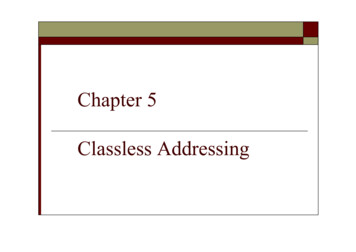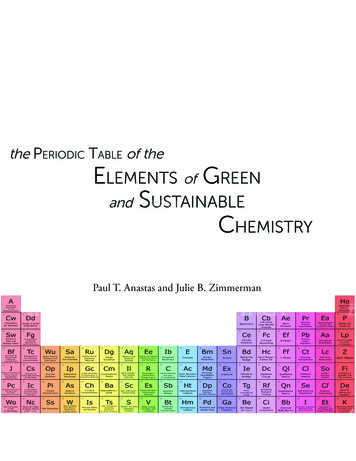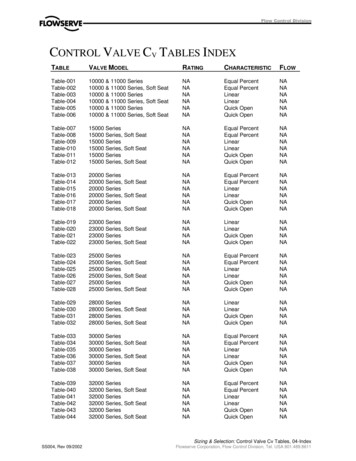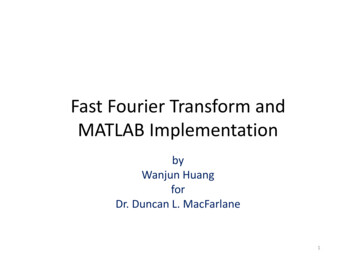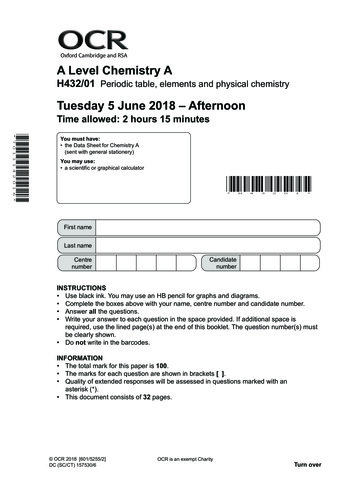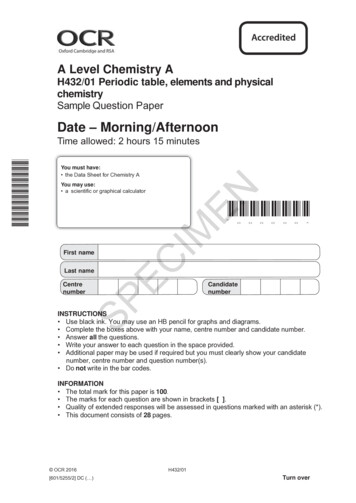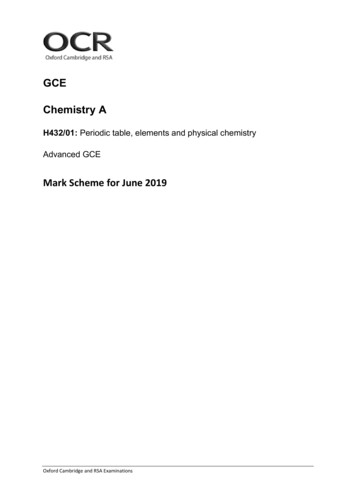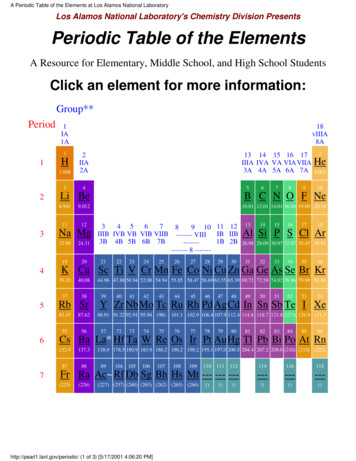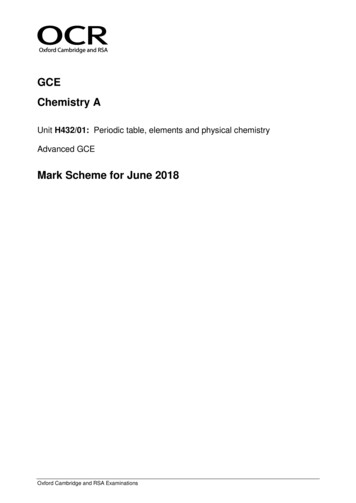
Transcription
GCEChemistry AUnit H432/01: Periodic table, elements and physical chemistryAdvanced GCEMark Scheme for June 2018Oxford Cambridge and RSA Examinations
OCR (Oxford Cambridge and RSA) is a leading UK awarding body, providing a wide range ofqualifications to meet the needs of candidates of all ages and abilities. OCR qualificationsinclude AS/A Levels, Diplomas, GCSEs, Cambridge Nationals, Cambridge Technicals,Functional Skills, Key Skills, Entry Level qualifications, NVQs and vocational qualifications inareas such as IT, business, languages, teaching/training, administration and secretarial skills.It is also responsible for developing new specifications to meet national requirements and theneeds of students and teachers. OCR is a not-for-profit organisation; any surplus made isinvested back into the establishment to help towards the development of qualifications andsupport, which keep pace with the changing needs of today’s society.This mark scheme is published as an aid to teachers and students, to indicate the requirementsof the examination. It shows the basis on which marks were awarded by examiners. It does notindicate the details of the discussions which took place at an examiners’ meeting before markingcommenced.All examiners are instructed that alternative correct answers and unexpected approaches incandidates’ scripts must be given marks that fairly reflect the relevant knowledge and skillsdemonstrated.Mark schemes should be read in conjunction with the published question papers and the reporton the examination. OCR 20182
H432/01Mark SchemeAnnotationsAnnotationDO NOT ALLOWALLOWMeaningAnswers which are not worthy of creditAnswers that can be accepted()Words which are not essential to gain creditUnderlined words must be present in answer to score a markAWAlternative wordingORAOr reverse argumentCorrect responseIncorrect responseOmission markBenefit of doubt givenContradictionRounding error3June 2018
H432/01Mark SchemeError in number of significant figuresError carried forwardLevel 1Level 2Level 3Benefit of doubt not givenNoted but no credit givenIgnore4June 2018
H432/01Mark SchemeJune 2018Subject-specific Marking InstructionsINTRODUCTIONYour first task as an Examiner is to become thoroughly familiar with the material on which the examination depends. This material includes: the specification, especially the assessment objectives the question paper the mark scheme.You should ensure that you have copies of these materials.You should ensure also that you are familiar with the administrative procedures related to the marking process. These are set out in the OCRbooklet Instructions for Examiners. If you are examining for the first time, please read carefully Appendix 5 Introduction to Script Marking:Notes for New Examiners.Please ask for help or guidance whenever you need it. Your first point of contact is your Team Leader.5
H432/01Mark SchemeJune 2018SECTION AO1.1Total156Guidance
H432/01Mark SchemeJune 2018SECTION BQuestion16(a)(i)AnswerMarks2(enthalpy change when)1 mole of gaseous ions reactOR 1 mole of hydrated/aqueous ions are formed GuidanceIGNORE ‘energy released’ OR ‘energy required’gaseous ions dissolve in waterOR gaseous ions form aqueous/hydrated ions (a)(ii)Ca2 (g) 2F–(g)Ca2 (aq) 2F–(g) 4Correct species AND state symbols required for eachmark. (mark independently) On 2nd line, ALLOW Ca2 (g) 2F–(aq)(i.e. F– hydrated before Ca2 )Ca2 (aq) 2F–(aq) CaF2(s)On 3rd line, ALLOW CaF2(aq) DO NOT ALLOW when first seen but ALLOW ECF for ‘ 2’missing and for use of the following ionsFl –F2–Ca /3 7
H432/01Mark SchemeQuestion(a) (iii)AnswerFIRST, CHECK THE ANSWER ON ANSWER LINEIF answer –504 (kJ mol–1) award 2 marksIF answer –1008 (kJ mol–1) award 1 ----------------------–June 2018Marks2‘–‘ sign is needed.2 hydH(F–) [–2630 13] – (–1609)OR – 2617 1609OR –1008 (kJ mol–1) hydH(F–) (a)(iv)GuidanceIF alternative answer, check to see if there is any ECFcredit possible using working below.COMMON ERRORS for 1 mark:( )2694: signs all reversed–2113:sign wrong for –1609–2126:sign wrong for 2630–517:sign wrong for 13 504:sign wrong–1008 –504 (kJ mol–1)2Correct comparison of hyd linked to sizes hydH (F–) more negative/exothermic (than hydH (Cl–))ANDF– has smaller size (than Cl–) Comparison of attraction between ions and waterF– OR smaller sized ion linked to greater attraction toH2O 82IF ALL 3 relevant values from the information at thestart of Q16a(iii) have NOT been used, award zeromarks unless one number has a transcription error,where 1 mark can be awarded ECFORAIGNORE ‘atomic’ before radius when comparing size ofionsIGNORE charge densityIGNORE electronegativityIGNORE nuclear attractionDO NOT ALLOW ‘forms stronger hydrogen bonds withwater’ OR ‘forms stronger van der Waals’ forces withwater’ALLOW ‘forms bonds’ for attraction’DO NOT ALLOW F- greater attraction to H2O if given aslarger ionAssume ‘F’ / ‘Fluorine’ means ‘ions’ but DO NOT ALLOW‘F molecules’
H432/01Mark SchemeQuestion(b)(i)(b)(ii)AnswerAverage bond enthalpyJune 2018GuidanceMarks2Breaking of one mole of bonds IGNORE energy required OR energy released IGNOREheterolytic / homolyticDO NOT ALLOW bonds formedDO NOT ALLOW ionic bondsIn gaseous molecules IGNORE species for moleculesFIRST, CHECK ANSWER ON ANSWER LINEIF answer ( ) 158 award 3 ----------------------3ANNOTATE ANSWER WITH TICKS AND CROSSESIGNORE signIGNORE signBond enthalpy of F–F( H for (O–H) bonds broken )1856 OR 4 464 (kJ mol–1) ALLOW ECFCommon errors( H for bonds made ) 2770 (kJ mol–1)OR 498 AND 2272 (kJ mol–1)OR 498 AND 4 568 (kJ mol–1) (bond enthalpy) F–F ( )158 (kJ mol–1) Award 2 marks for;–158 (Wrong sign)( )316(No 2)( ) 622 (use of 2 x 464)( ) 457 (omitting – 598)( ) 756 (use of 598)Award 1 mark for;( ) 970 (use of 2 x 464 and 598)2770 – 1856 – 5982Total915
H432/01Question17 (a)*Mark SchemeAnswerPlease refer to the marking instructions on page 5 of this markscheme for guidance on how to mark this question.Level 3 (5–6 marks)A comprehensive conclusion which uses quantitative results fordetermination of the reaction orders.ANDDetermines k from correct rate equation.ANDProposes the two-step mechanism which adds up to overallequation with no intermediate electrons.There is a well-developed line of reasoning which is clear andlogically structured. The information presented is relevant andsubstantiated. The working for the scientific content is clearlylinked to the experimental evidence.Level 2 (3–4 marks)Reaches a sound, but not comprehensive, conclusion based onthe quantitative results.ANDCorrectly identifies the orders and rate equation.ANDCalculates the rate constantORProposes the two-step mechanism with reactants of first stepmatching rate equation or matches ordersThere is a line of reasoning presented with some structure. Theinformation presented is relevant and supported by someevidence. The working for the scientific content is clearly linkedto the experimental evidence.10June 2018Marks6GuidanceIndicative scientific points may include:Orders and rate equation Fe3 1st order AND I– 2nd orderOR rate k[Fe3 ] [I–]2 Supported by experimental resultsCalculation of k, including units k correctly calculated AND correct units,e.g.8.10 10 4k 22.5(4.00 10 2) (3.00 10 2)2 dm6 mol–2 s–1 OR mol–2 dm6 s–1Two-step mechanism Two steps add up to give overall equation Slow step/ rate-determining step matchesstoichiometry of rate equation. Each step balances by species and chargee.g.Fe3 (aq) 2I–(aq) [FeI2] SLOWFe3 (aq) [FeI2] 2Fe2 (aq) I2(aq) FASTFe3 (aq) 2I–(aq) Fe2 (aq) I2–(aq) SLOWFe3 (aq) I2–(aq) Fe2 (aq) I2(aq)FASTFe3 (aq) 2I–(aq) Fe I2Fe3 (aq) Fe 2Fe2 (aq)SLOWFASTThere may be other feasible possibilities
H432/01QuestionMark SchemeAnswerJune 2018MarksLevel 1 (1–2 marks)Attempts to reach a simple conclusion for ordersANDAttempts a relevant rate equation.There is an attempt at a logical structure with a line ofreasoning. The information is in the most part relevant Theworking for the scientific content is clearly linked to theexperimental evidence.0 marksNo response or no response worthy of credit.11Guidance
H432/01Mark SchemeQuestion(b) (i)AnswerJune 2018Marks3GradientCorrect gradient calculated from best-fit straight linedrawn within the range 800 1040 Ea calculationEa (–) gradient 8.314 e.g. from 820, Ea ( )6817.48 (J mol–1)GuidanceALLOW lines which do not intercept y-axisALLOW mark for gradient if correct working shownwithin Ea calculation without gradient being calculatedseparatelyALLOW 0.8(00) 1.04(0)(omission of 10–3)ALLOW ECF for calculated gradient x 8.314If value of gradient not shown separately,ALLOW Ea in range: 6650 8650OR 6.65 8.65 (omission of 10–3)–3Ea to 3 SF AND use of 10 for gradient e.g. from 820, Ea ( )6820 (J mol–1)This mark subsumes gradient markNOTE: Omission of 10–3 can get 1st 2 marks12
H432/01Question(ii)Mark SchemeAnswerJune 2018Marks2Intercept shown on graphcould be by extrapolation of line, or label on y axisAND ln A linked to intercept valuee.g. ln A 31.4 GuidanceALLOW y 31.4ALLOW substitution of correct values of ln k and 1/Tinto ln k –Ea/R x 1/T ln A to give a value of ln Awhich approximately matches the intercept if givenln A ln k (Ea/R x 1/T)Calculation of A elnAOReln k ( Ea/R x 1/T)Calculation of A eintercept e.g. A e31.4 4.33 1013ALLOW ECF from incorrect ln Ae31.2 3.55 1013e31.3 3.92 1013e31.35 4.12 1013e31.45 4.56 1013e31.5 4.79 1013e31.6 5.29 1013e31.7 5.85 1013e31.8 6.46 1013e31.9 7.14 1013e32.0 7.9(0) 1013e32.1 8.73 1013IF 2 DP answer given, check rounding from calculatorvalue, not 3 DP values givenEg e31.7 5.8497 1013 and 5.8 1013(2SF)Total1311
H432/01Question18(a)Mark SchemeAnswerMarks22[NO2]Kc [NO]2 [O ] 2Units dm3 mol–1 (b)FIRST CHECK THE ANSWER ON THE ANSWERLINE IF answer 1.2 (mol) award 4 marks4Unless otherwise stated, marks are for correctlycalculated values. Working shows how valueshave been derived.June 2018GuidanceMust be square bracketsIGNORE state symbolsALLOW mol–1 dm3ALLOW mol dm–3 as ECF from inverted Kc expressionANNOTATIONS MUST BE USEDFor all parts, ALLOW numerical answers from 2 significantfigures up to the calculator valueIgnore rounding errors after second significant figure1st mark is for realising that concentrations need to becalculated.0.40[NO] 0.1(0) (mol dm–3)4.0AND0.80[O2] 4.0 0.2(0) (mol dm–3) ALLOW ECFCorrect numerical answer with no working would scoreall previous calculation marks[NO2]2 45 0.102 0.20 OR 0.09(0) [NO2] (45 0.102 0.20) OR 0.3(0) (mol dm–3) Making point 2 subsumes point 1amount NO2 0.30 4 1.2 (mol) Making point 3 subsumes points 2 and 1Common errors9.6 3 marks mol of NO and O2 used0.36 3 marks mol of NO2 calculated from [NO2]22.4 2 marks mol of NO and O2 used and no mol of NO2calculated14
H432/01Mark SchemeQuestion(c)(i)(c)AnswerMarks1ExothermicANDKp decreases as temperature increases June 2018GuidanceALLOW Kc for KpALLOW Equilibrium shifts to left hand side as temperatureincreases(ii)3FULL ANNOTATIONS NEEDEDALLOW Kc for Kp throughout the response.Equilibrium shift(Equilibrium position) shifts to right / forward /towards products Effect of increased pressure on Kp expressionRatio (in Kp expression) decreasesORDenominator/bottom of Kp expression increasesmore (than numerator/top) ALLOW Kp (initially) decreases for second marking point IFKp is seen to be restored later in the process.ALLOW more NO2 / product formed to restore KpALLOW ratio adjusts to restore KpEquilibrium shift (Kp expression)Ratio (in Kp expression) increases to restore KpORNumerator/top of Kp expression increases torestore Kp Total1510
H432/01Mark SchemeQuestion19 (a)(i)(ii)(iii)Answer Ka Marks1–[H ] [CH3COO ][CH3COOH] FIRST, CHECK ANSWER ON ANSWER LINEIF answer 4.76 award 3 ---------------------[H ] 10–pH 10–2.41 3.89 10–3 (mol dm–3) Ka[H ]2(3.89 10–3)2 [CH3COOH]0.870–5 1.74 10 (mol dm–3) pKa –log Ka –log 1.74 10–5 4.76 [H ]% dissociation [CH COOH] 10033.89 10–3 100 0.447(%) 0.8703June 2018GuidanceIGNORE state symbolsMust be square bracketsIGNORE expressions with HA or with [H ]2ALLOW use of HA and A–ALLOW 3 SF up to calculator value of:3.89045145 10–3 correctly roundedKa 1.739725573 10–3NOTE: 1.74 10–5 is same from unrounded [H ] calculatorvalue and 3 SF [H ] value1162 DP required3 SF required
H432/01Question(b)Mark SchemeAnswerFIRST, CHECK ANSWER ON ANSWER LINEIF answer 95.9(%) award 4 ---------------------[H ] 10–pH 10–13.48 3.31 10–14 (mol dm–3) June 2018Marks4GuidanceALLOW ECF throughoutIGNORE rounding errors beyond 3rd SF throughoutALLOW 3.3 10–14 (mol dm–3)[OH–] from Kw1.00 10–14 0.302 (mol dm–3) 3.31 10–14ALLOW 0.30ALLOW 0.303 if 3.3 10–14 used in the first marking pointALLOW pOH method:,pOH 14 – 13.48 0.52[OH–] 10–0.52 0.302 (mol dm–3)ALLOW [OH–] 0.1 40Mass of (NaOH)100 0.302 40.0 1.21 (g) 1000Rounding [OH–] to 0.3(0) gives 1.2/1.26 95.2%Award 4 marksRounding [OH–] to 0.303 gives 1.212/1.26 96.2%Award 4 marks% of NaOH to 3 SF1.21 1.26 100 95.9 (%) 17
H432/01Mark SchemeQuestion(c)AnswerMarks22–OCOOJune 2018GuidanceNOT REQUIRED Charge (‘2–‘) IGNORE incorrect charges Brackets CirclesIGNORE inner shellsALLOW rotated diagramGlobal rules C and O electrons must be shown differently,e.g. for C and for O Na electrons shown with different symbolALLOW diagram with missing C or O symbols.MARKINGBonding around central C atom 4 electrons for C shown as OR 4 electrons for O, different from C as OR C O bond with 2 C electrons AND 2 O electronsTwo C–O bonds with 1 C electron AND 1 OelectronIn C O bond, ALLOW sequence In C–O bond, ALLOW ‘extra’ electron with different symbolfor O electronNon-bonded (nb) electrons around 3 O atoms C O oxygen has 4 nb ‘O’ electrons Each C–O oxygen has 5 nb ‘O’ electronsAND 1 ‘extra’ electron with different symbolALLOW non-bonding electrons unpairedALLOW ‘extra’ electron as OR if it has been labelled‘extra electron’ or similarTotal1811
H432/01Question20 (a)Mark SchemeAnswerASSUME trend is down the group(unless stated otherwise)Marks3ForcesLondon forces increaseOR induced dipole(–dipole) interactions increase Reason(Number of) electrons increases June 2018GuidanceFULL ANNOTATIONS MUST BE ------------- ALLOWreverse argument throughoutIGNORE van der Waals’/vdW forcesDO NOT ALLOW hydrogen bonds OR permanent dipole(dipole) interactions for first and third marking pointsALLOW more (electron) shellsLink to energy and particlesMore energy to break intermolecular forcesORto break London forcesORto break induced dipole(–dipole) interactions DO NOT ALLOW covalent bonds break19
H432/01Mark SchemeQuestion(b)AnswerMarks3Ea: without catalystEnthalpyEc: with catalystGuidanceFULL ANNOTATIONS MUST BE USEDMark each point independentlyIGNORE state symbols.H2(g) I2(g)EcJune 2018 H: DO NOT ALLOW – H.ALLOW H arrow even with a gap at the top andbottom, i.e. does not quite reach reactant or productlineEa H2HI(g)Progress of reactionEa:2HI(g) on LHS AND H2(g) I2(g) on RHS ΔH labelled with product above reactantAND arrow upwards ALLOW no arrowhead or arrowheads at both endsof Ea lineEa line must reach (near or not too far beyond)maximums regardless of positionALLOW AE or EA for EaEa AND Ec correctly labelled with Ec below Ea Exothermic diagram can access the first and third marks20
H432/01Question(c)Mark SchemeAnswerFIRST CHECK THE ANSWER ON THE ANSWER LINEIF M 183 AND Formula Cl2O7 award 4 marksIF M 183 award 3 -----------------------------Use of data and unit conversions (R 8.314) T in K: 373K V in m3: 76.0 10-6 (p in Pa: 1.00 105) Calculation of n(1.00 105) (76.0 10–6)n 8.314 373Marks4June 2018GuidanceIf there is an alternative answer, check to see if thereis any ECF credit possible using working belowCorrect value of n subsumes first mark–3n 2.45 10 (mol) ALLOW ECF from incorrectly calculated nMolar massm0.4485M 183 (g mol–1) n 2.45 10–3ALLOW ECF from incorrect M if formula of ClxOy is theclosest to the with calculated value of MMolecular formulaCl2O7 IGNORE use of 24 000 cm3 for calculation of nBUT then Mark molar mass and Molecular formula byECF for two marks maximum.76.0n 3.17 10–3 (mol)240000.4485M 141.6/141.5 (g mol–1) 3.17 10–3Molecular formula Cl3O2 21
H432/01Mark SchemeQuestion(d) (i)AnswerTitres correct and ALL recorded to 2 decimal placesTitre: 24.0023.4023.75June 2018Marks2Guidance23.85 (d)(ii)mean titre 23.80 (cm3) 0.05 2Percentage uncertainty 100 0.43 (%) 23.40(d)(iii)Add starch (near the end point) 12ALLOW 23.8 cm3ALLOW ECF from incorrect subtraction in (i) or incorrectmeanALLOW 0.42% from titre values 2, 3 or 4 or mean titre ortrial titre.2 DP requiredALLOW blue/black OR black OR purple for colour ofmixtureALLOW blue colour disappears (to colourless)IGNORE ‘clear’IGNORE ‘colorimetry’Blue to colourless 22
H432/01Question(d) (iv)Mark SchemeAnswerFIRST CHECK THE ANSWER ON THE ANSWER LINEIF B RbIO3 AND relative formula mass 260.5 award 5marksIF relative formula mass 260.5 award 4 -----------------------------n(S2O32–) in titration0.150 23.80 3.57 10–3 (mol) 1000June 2018Marks5GuidanceALLOW ECF from incorrect mean titre in (a)(i)n(IO3–) in titration3.57 10–3 5.95 10–4 (mol) 6ECF from n(S2O32–) in titrationALLOW a two-step calculationn(I2) n(S2O32–) 2 and n(IO3–) n(I2) 3n(IO3–) in original 250 cm3 10 5.95 10–4 5.95 10–3 (mol) ECF from n(IO3–) in titrationECF from n(IO3–) in original 250 cm3IF scaling 10 is omitted,ALLOW ECF from n(IO3–) in titrationRelative formula mass of B1.55 260.5 (g mol–1) 5.95 10–3Formula of B (must be derived from relative formulamass)Iodate of Group 1 metal that most closely matchescalculated molar mass of BALLOW ECF from incorrect RFM of B provided metal isfrom Group 1ALLOW RbIO3–DO NOT ALLOW RbIO3 without relative formula massvalue.DO NOT ALLOW 260.4 (without working) and RbIO3IF B RbIO3 AND relative formula mass 261 award 5marksFormula from 260.5 RbIO3 Total2320
H432/01Mark SchemeQuestion21 (a)Ni:Answer1s 2s 2p 3s 3p 3d 4s2 22626Marks28Ni2 : 1s22s22p63s23p63d8 June 2018GuidanceALLOW 4s before 3d, ie 1s22s22p63s23p64s23d8ALLOW 1s2 written after answer prompt (ie 1s2 twice)ALLOW upper case D, etc and subscripts, e.g. .4S23D8ALLOW for Ni2 .4s0DO NOT ALLOW [Ar] as shorthand for 1s22s22p63s23p6Look carefully at 1s22s22p63s23p6 – there may be a mistake(b)(i)4Circuit:complete circuit AND voltmeter AND saltbridge linking two half-cells Voltmeter must be shown AND salt bridge must belabelledALLOW small gaps in circuitHalf cells: Pt AND I– AND I2 ALLOW half cells drawn either way aroundIGNORE 2 before I–(aq)DO NOT ALLOW I2(g) OR I2(s) OR I2(l)Ni AND Ni2 ALL conditions requiredBUT ALLOW 1 mol dm–3/1M if omitted here but shown forjust one solution in diagramLook on diagram in addition to answer linesStandard conditions:1 mol dm–3 solutionsAND 298 K / 25ºC IGNORE pressureNot relevant for this cellDO NOT ALLOW 1 mol for concentration(b)(ii)(c)(i)E 0.79 (V) H2O2(aq) 2H (aq) 2Fe2 (aq) 2Fe3 -(aq) 2H2O(l) 241IGNORE sign1ALLOW multiplesIGNORE state symbols, even if wrong
H032/01Question(c) (ii)Mark SchemeAnswerMarks4Equations2– June 2017GuidanceALLOW multiplesIGNORE state symbols, even if wrong3Zn(s) Cr2O7 (aq) 14H (aq)2 3 3Zn (aq) 2Cr (aq) 7H2O(l) Zn(s) 2Cr3 (aq) Zn2 (aq) 2Cr2 (aq) Comparison of E values (seen once)E of Zn is more negative/less positive than E ofCr2O72–ORE of Zn is more negative/less positive than E of Cr3 ALLOW Ecell is ( ) 2.09V for Zn/Cr2O72– cellORALLOW Ecell is ( ) 0.34V for Zn/Cr3 cellIGNORE ‘lower/higher’Equilibrium shift related to E valuesMore negative/less positive OR Zn system shifts leftORFor ‘shifts left’:ALLOW ‘(Zn) is oxidised’ OR ‘electrons are lost (from Zn)’For ‘shifts right’,ALLOW ‘(Cr) is reduced’ OR ‘electrons are gained’Less negative/more positive Cr2O72– system shiftsright OR Less negative/more positive Cr3 systemshifts right 25
H032/01Question(d)Mark SchemeAnswerPlease refer to the marking instructions on page 5 of thismark scheme for guidance on how to mark this question.Level 3 (5–6 marks)All three reactions are covered in detail with C, D, E and Fidentified with clear explanations.Marks6June 2017GuidanceIndicative scientific points may include:REACTION 1 (CuSO4/NH3)ProductC : [Cu(NH3)4(H2O)2]2 Equation2 [Cu(H2O)6]There is a well-developed line of reasoning which is clearand logically structured with clear chemicalcommunication and few omissions. The informationpresented is relevant and substantiated.Level 2 (3–4 marks)All three reactions are covered but explanations may beincompleteORTwo reactions are explained in detail.2 4H2OStructure of trans stereoisomerCorrect connectivityThere is an attempt at a logical structure with a line ofreasoning. The information is relevant e.g. formulae maycontain missing brackets or numbers and supported bysome evidence.Level 1 (1–2 marks)Make two simple explanations from any one reaction.ORMakes one simple explanation from each of two reactionsThere is an attempt at a logical structure with a line ofreasoning The information is in the most part relevant.0 marks 4NH3 [Cu(NH3)4(H2O)2]No response worthy of credit.26REACTION 2 (Cu2O/H2SO4)ProductsD : CuSO4 OR [Cu(H2O)6]2 E: CuEquationCu2O H2SO4 CuSO4 Cu H2OOxidation numbersCu( 1) Cu( 2) Cu(0)REACTION 3 (CuO/HNO3)EquationCuO 2HNO3 Cu(NO3)2 H2OMolar ratiosCu : H : N : O26.292.49 11.59 59.63 :::63.51.014.016.0Formula of FCuH6N2O9F: Cu(NO3)2 3H2O (OR Cu(NO3)2(H2O)3)
H032/01QuestionMark SchemeAnswerMarksTotal2718June ----------------------------Further guidance on use of wedges Must contain 2 ‘out wedges’, 2 ‘in wedges’ and 2 lines inplane of paper OR 4 lines, 1 ‘out wedge’ and 1 ‘inwedge’: For bond into paper, ALLOW: ALLOW following geometry:
OCR (Oxford Cambridge and RSA Examinations)The Triangle BuildingShaftesbury RoadCambridgeCB2 8EAOCR Customer Contact CentreEducation and LearningTelephone: 01223 553998Facsimile: 01223 552627Email: general.qualifications@ocr.org.ukwww.ocr.org.ukFor staff training purposes and as part of our quality assuranceprogramme your call may be recorded or monitoredOxford Cambridge and RSA Examinationsis a Company Limited by GuaranteeRegistered in EnglandRegistered Office; The Triangle Building, Shaftesbury Road, Cambridge, CB2 8EARegistered Company Number: 3484466OCR is an exempt CharityOCR (Oxford Cambridge and RSA Examinations)Head officeTelephone: 01223 552552Facsimile: 01223 552553 OCR 2018
Chemistry A Unit H432/01: Periodic table, elements and physical chemistry Advanced GCE Mark Scheme for June 2018. 2 OCR (Oxford Cambridge and RSA) is a leading UK awarding body, providing a wide range of qualifications to meet the needs of

